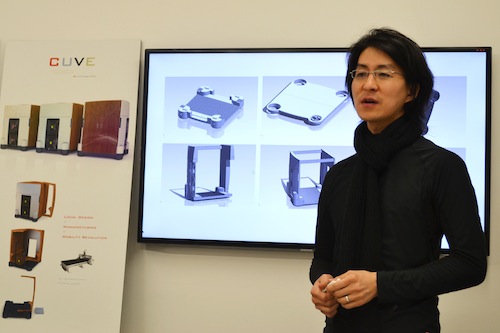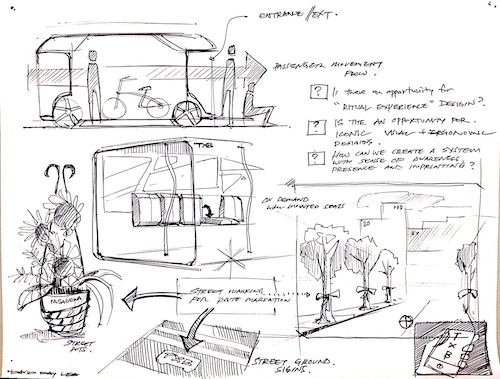
David Day Lee
Several semesters into Art Center’s Undergraduate Transportation Design program, and after an internship at one of the major automotive design studios in the Los Angeles area, David Day Lee realized that a career as a studio designer wasn’t his calling. He wanted to impact the automotive industry in a more comprehensive way. Lee talked to his professors and other faculty at Art Center about his wider interests—transportation mobility systems, integrated connectivity technology and cross-disciplinary strategic design solutions—and was invited to become the first student in Art Center’s vanguard Graduate Transportation Design program.
The approach would be a systematic one, “where you’re not just designing the vehicle,” Lee says, “but imagining vehicle design in the context of an ecosystem.”
Last week, he became the program’s first graduate. The Dotted Line caught up with him during his final term.
Lee knew he had something to contribute “to society at large or to industry, and yet I couldn’t exactly pinpoint how to do it. It wasn’t until I came to Art Center,” he says, “that I saw myself blossoming and found ways to apply my strengths and unique perspective and bring that to reality. It really is the setting that helped me to find my identity as a creative person, to know where I could belong and what I could do in this world.”
Because the then-fledgling Grad Transportation program wasn’t yet ready to launch, Lee initially spent three terms in the Graduate Industrial Design track, transferring to Grad Trans when it opened officially.
Lee’s path to transportation design was a roundabout one. Born in Korea and spending his early teens in Japan, Lee held international student status as a studio art major at Wheaton College, Illinois, where he also fulfilled his premed requirements. After graduation, Lee put both his art and medical school aspirations on hold to work as a mental health counselor and church pastor, while going through the immigration process to obtain his green card and eventual citizenship.
During that time, Lee realized where his real interests lay. As a community organizer and pastor, he says, “I was always looking for ways to design curricula and programs instead of the typical things that would be required of ministers.” Industrial and transportation design, he felt, would allow him to make practical application of his visualization skills and his love for solving problems.
Lee was drawn, too, to the prospect of creating products with international appeal. “As a person who lived through three cultures simultaneously on an everyday basis,” he says, “an international aspect to my career was very important. And the idea of being able to collaborate with creative people across international boundaries was also attractive. Transportation design seemed a perfect fit for that.”
Lee asked around and, learning that Art Center was the place to go, he put his house up for sale, left Chicago and drove to Southern California, “a decision that in the eyes of my family and close friends was crazy,” Lee say, “but it was the path that I thought was needed to get back to my roots.”
Today, Lee’s focus is about reimagining mobility as a technological and social change. “Using the smartphone as an analogy,” he says, “phones in general have gone through evolution in terms of how people relate to them. In the traditional sense, the phone was strictly a device we used to communicate with people who were at a distance. The way phones are used today is way beyond that.”
Part of what led to that evolution, Lee notes, “was that the phone has become a platform upon which people are able to design applications.” That has paved the way for “a grassroots-oriented development,” he says. “If we are able to see vehicles, too, as a platform where people could innovate their own usage and applications, what kind of systems could we see developing within our mobility systems?”

David Day Lee’s ideation board for CUVE mobility platform
For one possible answer, look to Lee’s Master’s thesis project, CUVE, a mobility platform that discards preconceived notions of public transportation and offers a solution based on individual aspirations. Inspired by Art Center’s recent expansion in Pasadena’s “Innovation Corridor,” five miles south of Hillside Campus, Lee and his fellow students were tasked with a challenge: design a better system of transporting students between the two campuses.
His solution? A crowd-branded transit experience that links individuals, communities and spaces. His CUVE system of autonomous eight-passenger vehicles combines the predictability of buses with the flexibility of taxis to accommodate the organic spontaneity of people’s lives. With smart “flex routes” that span multiple blocks, passengers can hail, board or disembark a vehicle at any point along the route. Further, CUVE would not only encompass a virtual and real space social network, but would act as a platform itself, allowing students to create a unique onboard social experience that would strengthen the community and, if expanded into the commercial realm, potentially result in revenue generation. Lee notes that his creative process changed over the course of his studies at Art Center. In the initial phase of his design approach, one of the first things that he does is to look at context. “I always want to see what is happening in the culture, in society, in technological realms. Who are the people who are considered to be the thought leaders at the current time? What sort of things do people consider to be aspirational?”
Lee then finds ways to integrate unrelated ideas together “and see if new ideas emerge from that dynamic. I look for insights from that contextual observation that could point toward a design opportunity. And then, based on the design brief, I go on to design the service or things based on those identified opportunities.”
The process, he emphasizes, is open-ended. “I don’t really see myself as the one who has executed the whole of the design. Maybe there is a further innovation to happen, based on the user’s and customer’s input. For me, transportation design is more about creating mobility experiences, rather than creating hardware or software that goes in the cars.”
That’s why Lee likes being described as an “experience designer,” he says. “It’s about creating meaningful engagement that people can have with a designed object. I see myself as a designer who can curate that process.”
He adds: “I would love to start my own design consultancy or mobility think tank, propagating my vision of what mobility systems could be, and how mobility could be reimagined as a solution that not only provides transportation solutions for people, but reimagines mobility as a way to solve a multitude of different problems.”
—Lynne Heffley is a Los Angeles-based freelance journalist who writes about the arts.
____
Read more about David Day Lee and Art Center’s Graduate Transportation Design program in the Los Angeles Register: Innovation: Car designers see custom tools for life’s journeys, April 23, 2014.









Pingback: Art Center College of Design Graduates Spring Forward - Innovate Pasadena
David, you inspire me in so many ways. I’m glad I met you. I love everything your about and keep it up.
-George Shallhoob